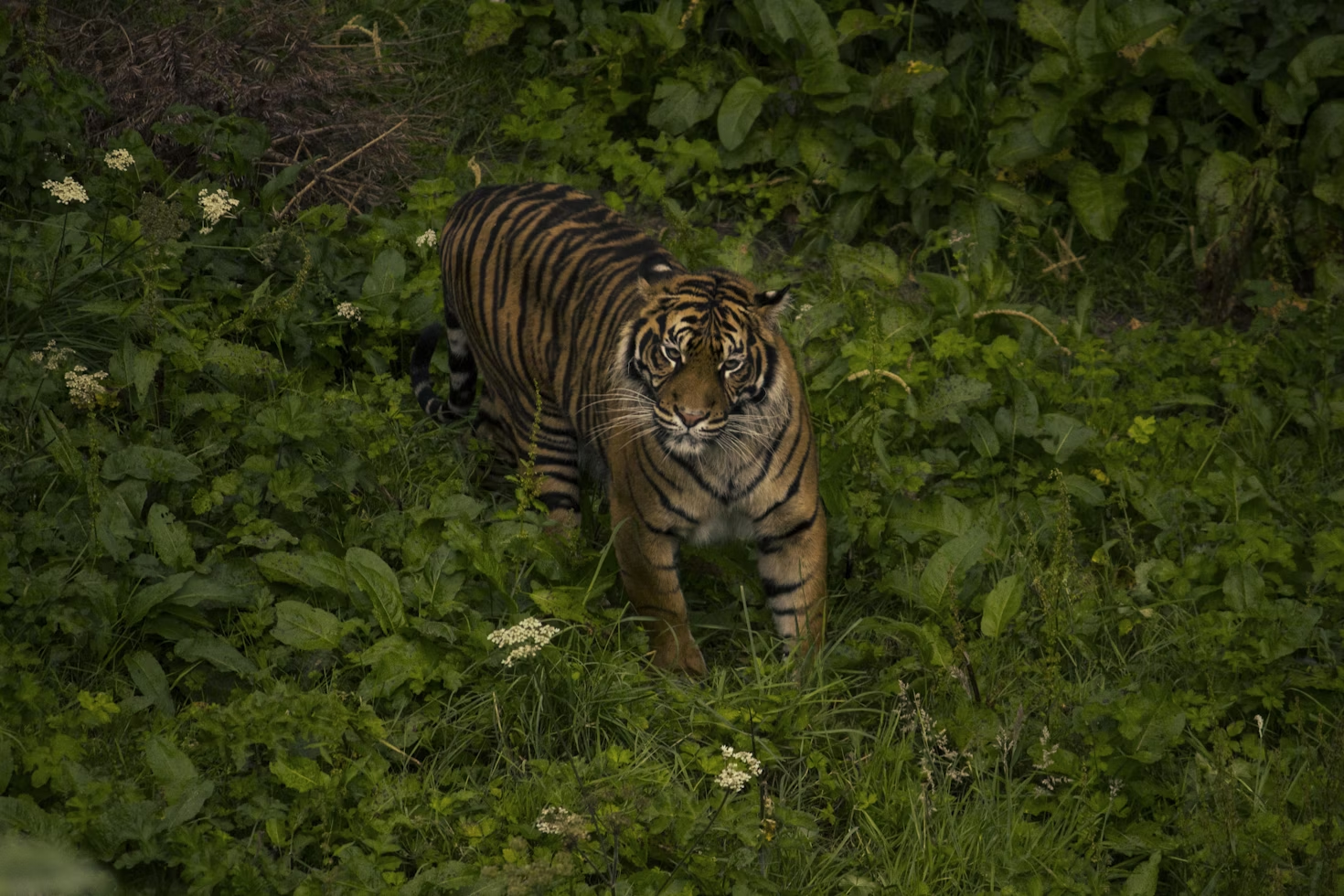Tiger -Things you should know about Tigers
With their striking coats, fierce presence, and untamed elegance, tigers stand as one of nature's most iconic and captivating creatures. As the largest of the big cats, tigers have fascinated and insp
With their striking coats, fierce presence, and untamed elegance, tigers stand as one of nature's most iconic and captivating creatures. As the largest of the big cats, tigers have fascinated and insp

With their striking coats, fierce presence, and untamed elegance, tigers stand as one of nature's most iconic and captivating creatures. As the largest of the big cats, tigers have fascinated and inspired awe for centuries. In this guide, we delve into the intricate world of tigers, unraveling fascinating details about their behavior, habitat, conservation status, and the crucial role they play in maintaining the ecological balance.
The Tiger's Kingdom: Tigers Panthera tigris are native to various parts of Asia, from the Siberian taiga to the mangrove swamps of the Sundarbans. They are adaptable creatures, inhabiting a range of ecosystems, from grasslands to dense forests.
Majestic Species: Tigers are the largest of the big cats, with males weighing between 200 to 680 pounds and measuring up to 10 feet in length. Their awe-inspiring size and distinctive orange coat adorned with black stripes make them instantly recognizable.
Species and Subspecies: There are six extant tiger subspecies: Bengal, Indochinese, Malayan, Siberian (Amur), South China, and Sumatran. Each subspecies has unique adaptations to its specific habitat, contributing to the tiger's incredible diversity.
Hunting and Diet: Tigers are carnivorous predators, with a diet consisting mainly of large ungulates such as deer, wild boar, and buffalo. They are solitary hunters, relying on stealth and strength to ambush their prey.
Endangered Status: Despite their regal stature, tigers face severe threats to their survival. Habitat loss, poaching for their skin and body parts, and human-wildlife conflict have led to a significant decline in tiger populations. As a result, all six tiger subspecies are classified as endangered or critically endangered.
Conservation Efforts: Conservation initiatives are underway to protect and preserve tiger populations. National parks, wildlife sanctuaries, and concerted global efforts aim to curb illegal poaching, protect habitats, and raise awareness about the importance of tiger conservation.
Reproductive Patterns: Tigers exhibit unique reproductive patterns. Females typically have a gestation period of around 93-112 days, after which they give birth to a litter of two to four cubs. The cubs remain with their mother until they are old enough to hunt independently.
Territorial Behavior: Tigers are territorial animals, with males having larger territories that may overlap with several female territories. They use scent markings, vocalizations, and physical displays to establish and defend their territories.
Cultural Significance: Tigers hold immense cultural significance in many societies. In various mythologies and belief systems, tigers are revered as symbols of strength, power, and protection. Their images often feature prominently in art, folklore, and spiritual practices.
Role in Ecosystem: Tigers play a crucial role in maintaining the ecological balance of their habitats. As apex predators, they help regulate prey populations and contribute to the overall health of the ecosystem.
Tigers, with their majestic presence and intrinsic role in nature, are more than just charismatic wildlife. They embody the delicate balance of ecosystems and serve as a poignant reminder of the urgent need for conservation. Understanding the intricacies of their behavior, the challenges they face, and the ongoing efforts to protect them is vital in ensuring that future generations can continue to marvel at the untamed beauty of these awe-inspiring creatures.
The Tiger's Kingdom

The Tiger's Kingdom
The Tiger's Kingdom refers to the diverse and vast habitats across Asia where various subspecies of tigers, belonging to the Panthera tigris species, inhabit. Tigers are found in a range of ecosystems, showcasing their adaptability to different environments. Here are more details about The Tiger's Kingdom:
Geographical Range: Tigers have historically inhabited a vast geographic range, stretching from the Siberian taiga in Russia to the mangrove swamps of the Sundarbans in Bangladesh and India. Their distribution spans diverse landscapes, including grasslands, savannas, deciduous and evergreen forests, and mangrove forests.
Habitats of Tiger Subspecies:
Adaptations to Environment: Tigers exhibit remarkable adaptations to their respective environments. For instance, Siberian Tigers have a thick fur coat to withstand cold climates, while Malayan Tigers have adapted to the tropical rainforests.
Territorial Behavior: Tigers are known for their territorial behavior within the Tiger's Kingdom. Males typically have larger territories that encompass the territories of several females. They mark their territories through scent markings, vocalizations, and physical markings to establish dominance.
Role in the Ecosystem: As apex predators, tigers play a crucial role in regulating prey populations, preventing overgrazing, and contributing to the overall health of ecosystems. Their presence maintains a balance in the food chain, influencing the distribution and behavior of other species within their habitats.
Conservation Challenges: The Tiger's Kingdom faces numerous conservation challenges, including habitat loss due to deforestation, human-wildlife conflict, and illegal poaching for their skins, bones, and other body parts. Conservation efforts are essential to ensure the survival of these majestic creatures.
Conservation Initiatives: Various conservation initiatives and national parks across the Tiger's Kingdom aim to protect and preserve tiger habitats. These efforts focus on anti-poaching measures, habitat restoration, community engagement, and raising awareness about the importance of tiger conservation.
Symbolism and Cultural Significance: Tigers hold immense cultural significance in the regions they inhabit within the Tiger's Kingdom. In many cultures, they are symbols of strength, power, and protection, featuring prominently in art, folklore, and spiritual practices.
Understanding the Tiger's Kingdom involves recognizing the intricate relationships between tigers and their habitats, the challenges they face, and the collective efforts required to ensure the survival of these magnificent big cats in the wild.
Bengal Tiger

Bengal Tiger
The Bengal Tiger (Panthera tigris tigris) is one of the most iconic and recognizable subspecies of tigers, known for its striking appearance, power, and cultural significance. Here are more details about the Bengal Tiger:
Geographical Range: The Bengal Tiger is primarily found in the Indian subcontinent, with its range encompassing countries such as India, Bangladesh, Bhutan, and Nepal. They inhabit diverse landscapes, including grasslands, mangrove swamps, deciduous forests, and the foothills of the Himalayas.
Appearance: Bengal Tigers are characterized by their distinctive orange coat adorned with dark, almost black, vertical stripes. Their underparts are typically white, and some individuals may have a slight tinge of cream in their coat. The stripes serve as effective camouflage in their natural habitats.
Size and Physical Features: Among the largest big cats, male Bengal Tigers can weigh between 400 to 550 pounds, while females are generally smaller, weighing around 220 to 350 pounds. They have a robust build, powerful limbs, and a well-defined head.
Habitat Preferences: Bengal Tigers are highly adaptable and can thrive in a variety of environments. They are commonly found in grasslands, mangrove swamps, and deciduous forests. The Sundarbans, a mangrove forest in the delta of the Ganges, Brahmaputra, and Meghna rivers, is known for its population of Bengal Tigers.
Behavior and Territoriality: Bengal Tigers are solitary animals and are known for their territorial behavior. Males typically have larger territories that overlap with those of several females. They use scent markings, vocalizations, and physical markings to establish and defend their territories.
Diet and Hunting: Bengal Tigers are carnivorous predators, with a diet consisting mainly of large ungulates such as deer, wild boar, and buffalo. They are adept hunters, using stealth and strength to ambush their prey.
Reproduction: Female Bengal Tigers have a gestation period of around 93 to 112 days and typically give birth to a litter of two to four cubs. The cubs remain under the protection and guidance of their mother until they are old enough to hunt independently.
Conservation Status: The Bengal Tiger is classified as Endangered on the International Union for Conservation of Nature (IUCN) Red List. Conservation efforts focus on protecting their habitats, addressing human-wildlife conflict, and implementing anti-poaching measures to ensure their survival.
Cultural Significance: Bengal Tigers hold immense cultural significance in the regions they inhabit. In Indian mythology and folklore, tigers are often associated with deities and are revered as symbols of power, strength, and protection.
Conservation Challenges: Conservation challenges for Bengal Tigers include habitat loss due to deforestation, human-wildlife conflict in areas where their habitats overlap with human settlements, and illegal poaching for their body parts.
Conservation Initiatives: Various conservation initiatives, including the establishment of national parks and wildlife sanctuaries, aim to protect Bengal Tigers and their habitats. These efforts involve community engagement, habitat restoration, and raising awareness about the importance of tiger conservation.
Understanding the Bengal Tiger involves appreciating its role in ecosystems, the conservation challenges it faces, and the collective efforts required to ensure the continued existence of this magnificent subspecies.
Indochinese Tiger

Indochinese Tiger
The Indochinese Tiger (Panthera tigris corbetti) is a subspecies of tiger native to the forested landscapes of Southeast Asia. Known for its distinct features and behaviors, the Indochinese Tiger faces various threats to its survival, making conservation efforts crucial. Here are more details about the Indochinese Tiger:
Geographical Range: The Indochinese Tiger is found in countries across Southeast Asia, including Cambodia, Laos, Vietnam, Thailand, Myanmar, and southwestern China. They inhabit diverse environments, ranging from evergreen and deciduous forests to grasslands.
Appearance: Indochinese Tigers share the characteristic tiger appearance, with a golden-orange coat adorned with dark vertical stripes. Their underparts are typically white, and their ears often have prominent white spots, adding to their distinctive features.
Size and Physical Features: Indochinese Tigers are medium-sized compared to some other tiger subspecies. Adult males can weigh between 330 to 430 pounds, while females are generally smaller. They have a more slender build and shorter fur compared to their larger counterparts.
Habitat Preferences: These tigers are adapted to various habitats within their range, including tropical and subtropical forests. They are known to navigate through hilly and mountainous terrain, showcasing their ability to thrive in diverse environments.
Behavior and Territoriality: Indochinese Tigers, like other tiger subspecies, are solitary animals and are known for their territorial behavior. Males typically have larger territories that overlap with those of several females. They use scent markings, vocalizations, and physical markings to establish and defend their territories.
Diet and Hunting: Indochinese Tigers have a carnivorous diet, preying on various ungulates such as deer, wild boar, and other smaller mammals. They are skilled hunters, using their strength and stealth to ambush their prey.
Reproduction: Female Indochinese Tigers have a gestation period of approximately 93 to 112 days, after which they give birth to a litter of two to four cubs. The cubs remain under the care of their mother until they are old enough to venture out and hunt independently.
Conservation Status: The Indochinese Tiger is classified as Endangered on the International Union for Conservation of Nature (IUCN) Red List. Like many other tiger subspecies, the Indochinese Tiger faces threats such as habitat loss, poaching, and human-wildlife conflict.
Conservation Challenges: Conservation challenges for the Indochinese Tiger include habitat fragmentation due to deforestation, illegal wildlife trade, and the depletion of prey species. Human encroachment on their habitats poses a significant threat.
Conservation Initiatives: Conservation efforts for the Indochinese Tiger involve the establishment and management of protected areas, anti-poaching measures, community engagement, and international collaborations. These initiatives aim to address the various threats and secure the long-term survival of the subspecies.
Understanding the Indochinese Tiger involves recognizing its unique features, behaviors, and the conservation challenges it faces in the rapidly changing landscapes of Southeast Asia. Conservation efforts are critical to ensuring the continued existence of this remarkable tiger subspecies.
Malayan Tiger

Malayan Tiger
The Malayan Tiger (Panthera tigris jacksoni) is a subspecies of tiger native to the Malay Peninsula and parts of southern Thailand. Known for its distinctive features and adaptations to its tropical rainforest habitat, the Malayan Tiger faces significant conservation challenges. Here are more details about the Malayan Tiger:
Geographical Range: The Malayan Tiger's range includes the Malay Peninsula, which encompasses parts of Malaysia and southern Thailand. They inhabit a variety of environments, including lowland and montane forests.
Appearance: Malayan Tigers exhibit the typical tiger appearance, characterized by a striking golden-orange coat with dark vertical stripes. Their underparts are generally white, and they may have a slightly smaller size compared to some other tiger subspecies.
Size and Physical Features: Adult Malayan Tigers typically weigh between 200 to 300 pounds, with males being larger than females. They have a robust build, powerful limbs, and a well-defined head. The size of Malayan Tigers is influenced by their adaptation to the tropical rainforest environment.
Habitat Preferences: Malayan Tigers are adapted to the tropical rainforests of the Malay Peninsula. They navigate through dense vegetation, utilizing their agility and stealth to hunt and move within their habitat.
Behavior and Territoriality: Like other tiger subspecies, Malayan Tigers are solitary animals and exhibit territorial behavior. Males generally have larger territories that overlap with those of several females. They use scent markings, vocalizations, and physical markings to establish and defend their territories.
Diet and Hunting: Malayan Tigers have a carnivorous diet, feeding on a variety of prey including deer, wild boar, and other smaller mammals found in the rainforest. They are skilled hunters, relying on their powerful physique and camouflage to ambush their prey.
Reproduction: Female Malayan Tigers have a gestation period of around 93 to 112 days and typically give birth to a litter of two to four cubs. The cubs stay with their mother until they are old enough to venture out on their own and learn hunting skills.
Conservation Status: The Malayan Tiger is classified as Critically Endangered on the International Union for Conservation of Nature (IUCN) Red List. The population is under threat due to habitat loss, poaching, and human-wildlife conflict.
Conservation Challenges: Conservation challenges for the Malayan Tiger include habitat fragmentation caused by deforestation for agriculture, logging, and palm oil plantations. Poaching for their skin, bones, and other body parts, as well as the depletion of prey species, further threaten their survival.
Conservation Initiatives: Conservation efforts for the Malayan Tiger involve the establishment and protection of tiger reserves, anti-poaching measures, habitat restoration, and community engagement. International collaborations play a crucial role in addressing the complex challenges faced by this subspecies.
Understanding the Malayan Tiger involves recognizing its unique adaptations to the tropical rainforest, the conservation challenges it confronts, and the urgent need for comprehensive efforts to secure its future in the wild. Conservation initiatives are pivotal in ensuring the survival of this critically endangered subspecies.
Siberian Tiger

Siberian Tiger
The Siberian Tiger (Panthera tigris altaica), also known as the Amur Tiger, is the largest of all tiger subspecies and is renowned for its distinctive appearance and resilience in harsh climates. Native to the Russian Far East and parts of China, the Siberian Tiger faces conservation challenges that warrant attention and concerted efforts. Here are more details about the Siberian Tiger:
Geographical Range: The Siberian Tiger's natural range extends through the Russian Far East, including the Primorsky Krai region, and parts of northeastern China. The taiga, a biome characterized by coniferous forests, is a primary habitat for Siberian Tigers.
Appearance: Siberian Tigers are distinguished by their large size and robust build. They possess a thick and dense coat, which serves as insulation in the cold climate of their habitat. The coat color ranges from a pale orange to a deep rusty hue, with distinct dark stripes.
Size and Physical Features: Adult male Siberian Tigers can weigh between 400 to 675 pounds, with exceptional individuals reaching even higher weights. Females are generally smaller, weighing between 220 to 368 pounds. The Siberian Tiger's large size is an adaptation to its cold environment.
Habitat Preferences: Siberian Tigers are adapted to the taiga biome, which consists of coniferous forests interspersed with wetlands and grasslands. The vast and remote landscapes of the Russian Far East provide these tigers with ample room to roam and hunt.
Behavior and Territoriality: Siberian Tigers, like other tiger subspecies, are solitary animals and exhibit territorial behavior. Males typically have larger territories that overlap with those of several females. They use scent markings, vocalizations, and physical markings to establish and defend their territories.
Diet and Hunting: Siberian Tigers have a diverse diet that includes ungulates like deer and wild boar, as well as smaller mammals such as hares and fish. Their powerful limbs and strong jaws make them effective hunters, capable of taking down prey much larger than themselves.
Reproduction: Female Siberian Tigers have a gestation period of around 93 to 112 days, after which they give birth to a litter of two to six cubs. The cubs stay with their mother for an extended period, learning essential hunting skills before becoming independent.
Conservation Status: The Siberian Tiger is classified as Endangered on the International Union for Conservation of Nature (IUCN) Red List. Conservation efforts focus on preserving its habitat, combating poaching, and addressing human-wildlife conflict.
Conservation Challenges: Conservation challenges for the Siberian Tiger include habitat loss due to logging, infrastructure development, and the impact of climate change on their natural environment. Poaching for their skins, bones, and other body parts further threatens their survival.
Conservation Initiatives: Conservation efforts for the Siberian Tiger involve the establishment of protected areas, anti-poaching measures, habitat restoration, and community engagement. International collaboration is essential in addressing the complex challenges faced by this subspecies.
Understanding the Siberian Tiger involves appreciating its adaptation to the harsh taiga environment, acknowledging the conservation challenges it confronts, and actively participating in global efforts to ensure the survival of this magnificent and endangered tiger subspecies.
South China Tiger

South China Tiger
The South China Tiger (Panthera tigris amoyensis) is a critically endangered subspecies of tiger native to southern China. As one of the most endangered big cats globally, the South China Tiger faces numerous threats, and comprehensive conservation efforts are essential to prevent its extinction. Here are more details about the South China Tiger:
Geographical Range: Historically, the South China Tiger's range extended across various provinces in southern China. However, as of the last few decades, there have been no confirmed sightings of wild South China Tigers, leading to concerns about their current status.
Appearance: South China Tigers exhibit the typical tiger appearance, characterized by a bright orange coat with dark vertical stripes. They have a distinct and recognizable appearance, with a pattern of narrow and closely spaced stripes.
Size and Physical Features: Adult South China Tigers are medium-sized compared to other tiger subspecies. Males typically weigh around 330 pounds, while females are slightly smaller. They have a robust build, powerful limbs, and a well-defined head.
Habitat Preferences: Historically, South China Tigers inhabited a variety of environments, including forests, grasslands, and swamps. However, due to extensive habitat loss and fragmentation, their natural habitats have been severely diminished.
Behavior and Territoriality: Like other tiger subspecies, South China Tigers are believed to be solitary animals exhibiting territorial behavior. However, due to the scarcity of recent sightings, much of their behavioral characteristics remain speculative.
Diet and Hunting: South China Tigers are presumed to have a diet consisting of various ungulates, such as deer and wild boar, as well as smaller mammals. Their hunting behavior likely involves stealth and ambush tactics to capture prey.
Reproduction: Limited information is available about the reproductive behavior of South China Tigers. Like other tiger subspecies, females likely have a gestation period of around 93 to 112 days, giving birth to a litter of two to four cubs.
Conservation Status: The South China Tiger is classified as Critically Endangered on the International Union for Conservation of Nature (IUCN) Red List. Despite extensive conservation efforts, there have been no confirmed sightings of wild individuals in recent years, raising concerns about their functional extinction in the wild.
Conservation Challenges: The primary conservation challenges for the South China Tiger include habitat loss due to agricultural expansion, human-wildlife conflict, and a decline in prey species. Additionally, historical persecution and illegal poaching have contributed to their critical status.
Conservation Initiatives: Conservation efforts for the South China Tiger involve breeding programs in captivity, aiming to maintain genetic diversity and potentially reintroduce individuals into protected areas. Initiatives also focus on habitat restoration, community engagement, and raising awareness about the importance of tiger conservation.
The South China Tiger's critical status underscores the urgent need for conservation actions to preserve this subspecies and prevent its extinction. Captive breeding programs and habitat restoration initiatives play a pivotal role in ensuring the survival of the South China Tiger for future generations
Sumatran Tiger

Sumatran Tiger
The Sumatran Tiger (Panthera tigris sumatrae) is a critically endangered subspecies of tiger native to the Indonesian island of Sumatra. Known for its unique characteristics and the severe threats it faces, the conservation of the Sumatran Tiger is of utmost importance. Here are more details about the Sumatran Tiger:
Geographical Range: The Sumatran Tiger is found exclusively on the island of Sumatra in Indonesia. They inhabit a variety of ecosystems, including lowland forests, montane forests, and peat swamps.
Appearance: Sumatran Tigers are characterized by their dark, vibrant orange coat with closely spaced dark stripes. They have a more bearded and maned appearance compared to other tiger subspecies, with longer fur around the face and neck.
Size and Physical Features: Adult Sumatran Tigers are smaller in size compared to other tiger subspecies. Males typically weigh between 220 to 310 pounds, while females are generally smaller. Their smaller size is an adaptation to the limited availability of large prey on the island.
Habitat Preferences: Sumatran Tigers are adapted to various habitats on the island, including lowland rainforests, mountainous regions, and peat swamps. They navigate through diverse landscapes, using their agility to traverse different terrains.
Behavior and Territoriality: Sumatran Tigers, like other tiger subspecies, are solitary animals and exhibit territorial behavior. Males typically have larger territories that overlap with those of several females. They use scent markings, vocalizations, and physical markings to establish and defend their territories.
Diet and Hunting: Sumatran Tigers have a diverse diet that includes various prey species such as deer, wild boar, and smaller mammals. Their agile and stealthy nature allows them to navigate through dense forests and effectively ambush their prey.
Reproduction: Female Sumatran Tigers have a gestation period of around 93 to 112 days, after which they give birth to a litter of two to four cubs. The cubs remain under the care of their mother until they are old enough to venture out and hunt independently.
Conservation Status: The Sumatran Tiger is classified as Critically Endangered on the International Union for Conservation of Nature (IUCN) Red List. The population is under severe threat due to habitat loss, illegal poaching, and human-wildlife conflict.
Conservation Challenges: Conservation challenges for the Sumatran Tiger include extensive habitat loss due to deforestation for palm oil plantations, agricultural expansion, and logging. Additionally, illegal poaching for their skins, bones, and other body parts poses a significant threat.
Conservation Initiatives: Conservation efforts for the Sumatran Tiger involve the establishment and protection of tiger reserves, anti-poaching measures, habitat restoration, and community engagement. International collaboration is crucial in addressing the complex challenges faced by this subspecies.
The conservation of the Sumatran Tiger requires urgent and comprehensive efforts to protect its remaining habitat, combat illegal poaching, and address the broader issues of habitat destruction. Ensuring the survival of the Sumatran Tiger is not only crucial for the species itself but also for the health and balance of the ecosystems it inhabits.
Writer and content creator
Log in to share your thoughts and engage with other readers.